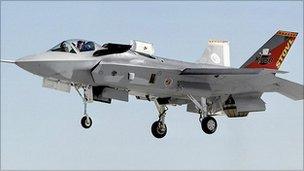Joint Strike Fighter: Jet that's a 'spy in the sky'
- Published
Squadron Leader Steve Long of the UK's RAF explained the capabilities of the F-35 in 2010
As the most expensive defence project ever undertaken starts to come to fruition, the BBC has been given exclusive access to the world's most advanced fighter jet, the Joint Strike Fighter or F-35.
Development of the next generation of warplane is already over budget and behind schedule.
Hidden in a hangar at the US Navy's Patuxent River Air Base, in Maryland, away from prying eyes and shaded from the intense sun, US and British ground crew made the final preparations before the plane took to the clear blue skies.
RAF and Royal Navy personnel are already working alongside American crews as they conduct the final trials before it goes into production.
There's nothing particularly unusual about the Lockheed Martin JSF's appearance. It looks like a modern jet fighter. It's what you can't see that makes it so special - its software and intelligence-gathering capabilities.
Squadron leader Steve Long is the first RAF pilot to fly the single-seat plane.
He says he can't believe his luck. He's like an enthusiastic boy who's just been given a very expensive toy.
Sitting in the sleek cockpit he explains the plane's uniqueness. He says the obvious advantage of the aircraft is its stealth - or low visibility. It's like a well known brand of lager - it can reach parts of the world that others cannot.
But there's much more.
The JSF is also a spy in the sky. It can gather information from space, land and other aircraft - and then transmit that information to commanders on the ground.
The pilot has a "god's eye" view at of the battlefield. Sqn Ldr Strong shows how, at the press of a button, he can activate a camera underneath that enables him to see right through the plane.
As for flying, he says its almost "brainless". The plane knows how to go into a hover better than the best Harrier pilot. Instead of jockeying with levers the pilot is left focusing on its warfighting role.
Even someone with little flying experience - like me - could land the plane on an aircraft carrier. Admittedly in my case it was done on a simulator.
Jonathan Beale tries his hand at the Joint Strike Fighter simulator
But does Britain really need this kind of plane, and can the country afford it? Those are questions now being addressed by the Strategic Defence and Security Review, currently under way. Many defence experts see the Joint Strike Fighter programme as vulnerable to cuts.
The cost has already rung alarm bells in Washington. The Americans - who expected the planes in 2010 but are now looking at delivery in 2012 - plan to buy 2,450 aircraft at a cost of more than $320bn (£210bn). That represents almost half of the Pentagon's annual budget.
The US's costs are greater because they are ordering three different versions of the plane - one for the US Airforce that can land and take off on a conventional runway, one for the US Navy that can be catapulted off their large aircraft carriers, and one for the US Marine Corps that - like the British version - will have a short take-off and vertical landing (STOVL) capability.
'Cold war legacy'
Britain had planned to buy around 150 aircraft for the RAF and Royal Navy. But with each plane costing at least £70m - compared with the £30m price tag expected a decade ago - that number is likely to fall.
The British defence industry, alongside the RAF and Navy, is mounting a vigorous campaign to back the project.

Each plane costs at least £70m
They point out that although Britain is only paying for about 4% of the costs, it stands to gain about 15% of the business. More than 100 British companies are involved in developing the plane.
BAE Systems is getting the lion's share. At its factory in Samlesbury they are building the aft fuselage for every plane produced. So, the argument goes, cuts in production would hurt British business.
The question of whether Britain really needs it can only be answered in the context of the government's military ambitions.
A stealth strike fighter is a polite term for an offensive weapon. The JSF is an aircraft that could be used to enter enemy airspace undetected in, say, a country like Iran.
Sqn Ldr Long doesn't mention Tehran, but he does say that this is the kind of plane you would need if you "want to be a credible threat or to rattle a sabre".
But does buying it make any sense when the Ministry of Defence is having to contemplate cuts of 25%?
A look at the Joint Strike Fighter's electronics
Defence analyst Paul Beaver insists it does not. He says it's a "cold war legacy-thinking plane" that is simply "too complex and too expensive".
The JSF could be the last manned fighter jet to go into mass production. Airforces around the world are increasingly turning to drones.
That said, with the Harrier Jet coming to the end of its life and with the Royal Navy requiring a short take off and vertical landing plane for its two new aircraft carriers, the likelihood is that Britain will buy the Joint Strike Fighter.
But probably not as many as the RAF and Navy had hoped.